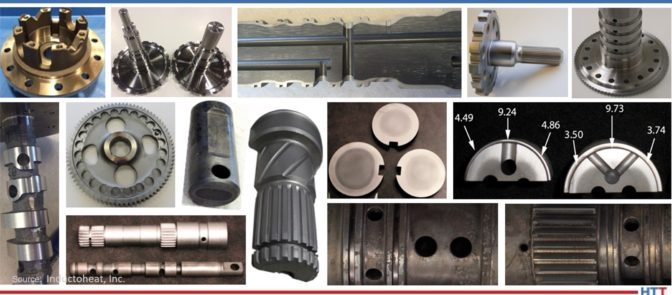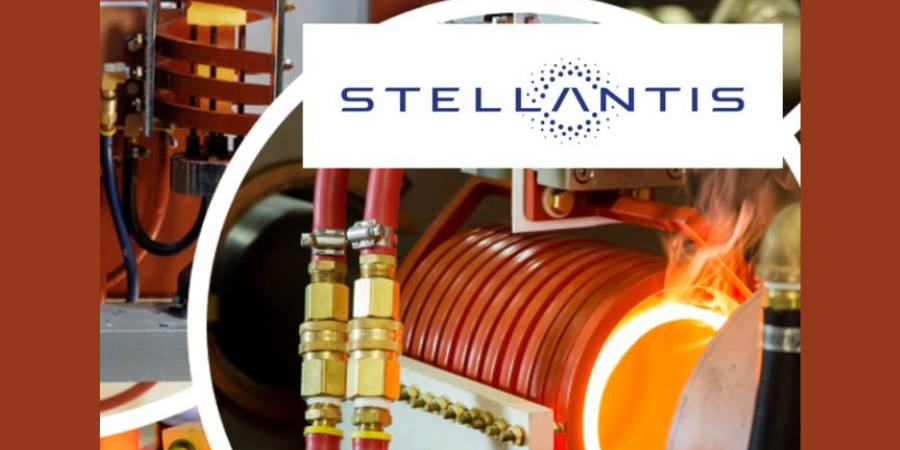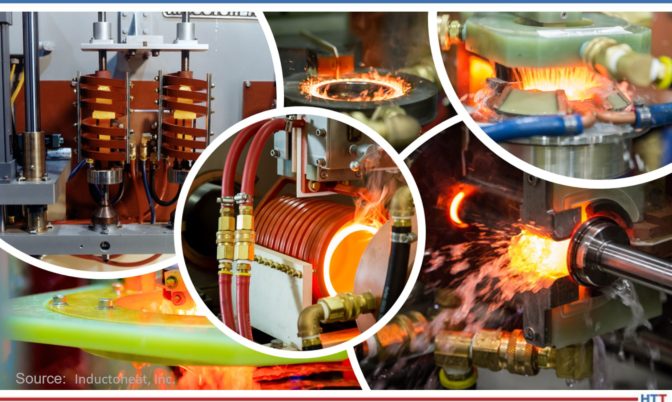![]() An induction heat treat equipment supplier is offering customized, process-specific training seminars to a leading automotive part manufacturer. With the growing need for training and education among new and less experienced employees, these highly effective training strategies are growing in popularity.
An induction heat treat equipment supplier is offering customized, process-specific training seminars to a leading automotive part manufacturer. With the growing need for training and education among new and less experienced employees, these highly effective training strategies are growing in popularity.
This article shows how one induction heat treat equipment supplier, Inductoheat, has helped Stellantis, a leading automotive manufacturer, improve its in-house heat treat operations and further excel its technology.
This article appears in Heat Treat Today's 2021 Automotive August print edition. Go to our digital editions archive to access the entire print edition online!
Introduction
Stringent demands to dramatically minimize transmission noise in hybrid and electric vehicles (EV) as well as in modern internal combustion powered vehicles (ICE) call for innovative technologies allowing to suppress distortion of heat-treated parts, while further enhancing their metallurgical quality and performance characteristics.
 Light-weighing initiatives have become essential in vehicle designs. To minimize weight and cost of automotive components, designers might choose to drill holes, reduce cross sections, make intricate transitions, cutouts, re-entrant corners, and custom shapes. In some cases, such attempts result in a component’s geometries that might be prone to cracking during heat treating or might be associated with excessive distortion. Many times, complex geometries of components are linked to intricate hardness patterns and specific requirements for magnitude and distribution of residual stresses.
Light-weighing initiatives have become essential in vehicle designs. To minimize weight and cost of automotive components, designers might choose to drill holes, reduce cross sections, make intricate transitions, cutouts, re-entrant corners, and custom shapes. In some cases, such attempts result in a component’s geometries that might be prone to cracking during heat treating or might be associated with excessive distortion. Many times, complex geometries of components are linked to intricate hardness patterns and specific requirements for magnitude and distribution of residual stresses.
To be competitive and successfully develop high performance/low distortion components, induction heat treatment users must have a clear understanding of not only principles of electromagnetic induction and associated metallurgical subtleties, but also have awareness of recent theoretical discoveries and technological breakthroughs to further advance part designs.
On multiple recent occasions, Inductoheat has been approached by automotive industry and heat treat suppliers to develop process-specific training seminars as a knowledge-sharing eff ort to give insights on various aspects associated with induction thermal technology. As a response, Inductoheat has developed several practical-oriented training seminars for the automotive industry. These seminars allow present and potential users of induction technologies to understand basic and advanced knowledge associated with electromagnetic induction and to learn novel theoretical achievements, process developments, technological breakthroughs, and practical recommendations.
Another goal in developing these technical seminars is to minimize the negative impact of a generation gap by helping young professionals involved in induction heating to better understand its subtleties and metallurgical intricacies and clarify common misconceptions and confusions existing in different publications.
Best practices and simple solutions for typical induction heating challenges, as well as do and don’t items in designing and fabricating coils are explained. The subject of induction hardening of complex geometry parts (including but not limited to gears, gear-like and shaft-like parts, raceways, camshafts, and other critical components) is also thoroughly discussed, describing inventions and innovations that have occurred in the last three to five years.
Understanding a broad spectrum of interrelated factors associated with various failure modes of heat treat components is an important step in designing new products and developing robust and sustainable processes. Aspects related to failure analysis, part longevity, process monitoring, quality assurance, and robustness of induction systems, novel semiconductor inverter technologies, as well as specifics of implementing Industry 4.0 operating strategy in induction heat treating are also addressed in these seminars. Various design concepts and advanced process recipes/protocols are analyzed to help reduce the energy consumption of induction equipment and enhance cost effectiveness.
Some people traditionally view induction heating as a standalone process or system. Presented materials clearly reveal a necessity to consider induction equipment as part of an integrated system that includes all elements (such as previous process stages and their metallurgical implications, stress analysis, load matching capabilities, and many others) that must be considered to accomplish the process goal.
Finally, Inductoheat conducts these technical video seminars free of charge, addressing specific subjects defined by a particular automotive manufacturer or heat treat supplier.
Technical Seminars for Stellantis
Inductoheat recently conducted two free technical video seminars addressing subjects selected by Stellantis that included aspects related to modern induction thermal processing for traditional ICE vehicle and EV markets.
The first seminar in April was devoted to “Troubleshooting Failures and Prevention in Induction Hardening: General Useful Remedies, Impact of Geometrical Irregularities and Improper Designs.”
In May, the second seminar focused on “Novel Developments and Prospects of Using Induction Heat Treating for Electrical Vehicles (EV).”
Both seminars had the same format: 90 minutes of oral presentations by Inductoheat’s team followed by 20 minutes of Q&A sessions. Attendees included heat treat practitioners, engineers, metallurgists, managers, and scientists involved in induction heating technologies in application to the automotive industry. There were 220 professionals from Stellantis North America registered for the first seminar alone.
Step-by-Step Remedies to Minimize the Probability of Abnormal Outputs
A virtually endless variety of components are routinely induction hardened for different sectors of the industry (Figure 1). Many of these components have their own “personalities” that affect the outcome of heat treatment. Troubleshooting tips and practical remedies to prevent unspecified outputs associated with induction hardening have been developed by industry experts and shared with professionals involved in induction thermal processing. This enhances the knowledge of designers of automotive components and minimizes the probability of cracking and excessive distortion in industrial practice.
Possible abnormal outputs associated with induction hardening include:
- Inappropriate microstructures (undesirable phases or their mixtures)
- Unacceptable hardness levels (too high or too low)
- Inadequate hardness case depths (too deep or too shallow)
- Hardness inconsistency/inappropriate hardness pattern (e.g., a deviation of a run-off region)
- Excessive grain coarsening, decarburization, oxidation, and scaling
- Unacceptable distortion (size distortion and/or shape distortion)
- Unfavorable transient stresses/undesirable magnitude and distribution of residual stresses
- Crack development and propagation
There is a variety of factors that need to be considered to ensure that abnormal heat treat outputs do not occur. Those factors can be divided into four large groups: 1, 2
- Prior microstructure and composition of incoming material
- Parts geometry related
- Inductor design related
- Process protocol related
Inadequate equipment selection or unsuitable heat treat process protocols may be unfit for certain geometrical features of parts or required hardness patterns. It is difficult to overestimate the importance in having a sufficient degree of familiarity with the hardening equipment and process specifics of a particular machine under investigation. Underestimating geometrical irregularities of components (including a presence of holes, keyways, grooves, shoulders, flanges, undercuts, sharp corners, and other geometrical irregularities) by novices as well as a danger of misjudging an impact of different process factors on the outcome of heat treatment have been reviewed in these seminars. Numerous practical case studies and solutions to prevent abnormal outputs have been shared.

Presence of Holes on Selecting Appropriate Inductor Style and Process Protocol
It is not unusual for transmission and engine components to contain multiple longitudinal (axial) and/or transverse (radial) holes, as well as angled or cross holes (Figure 2). Induction practitioners can face certain challenges when dealing with parts containing holes. Distortion of the eddy current flow in the hole area can result in the undesirable combination of “hot” and “cold” spots, excessive shape distortion, and unwanted metallurgical microstructures, which weakens grain structure and substantially increases brittleness and sensitivity to intergranular cracking.
It is important to carefully evaluate the imaginary eddy current flow lines in the vicinity of oil holes. Surprisingly, in many cases, a proper selection of induction hardening technique (for example, single-shot vs. scanning vs. static hardening) in combination with other factors can be essential in helping to dramatically improve heat uniformity and eliminate regions with localized grain boundary liquation that could act as crack-initiation sites.
There are several helpful practical solutions and knowhow shared with heat treaters during these seminars helping to develop robust and failure-free induction hardening processes. For example, appropriate coil copper profiling often allows dramatically reducing or eliminating hot spots in the vicinity of holes. Some of those solutions allow selectively controlling heat source distribution along the oil hole perimeter by providing preferable channels for eddy current flow. Several patented design concepts have been revealed.
It should be recognized that temperature surplus alone might not result in cracking. There are other factors that can contribute to overheating, thereby increasing crack sensitivity. Steel chemical composition is one of those factors. Steels having higher carbon contents are more prone to cracking. Besides carbon content, an unfavorable combination of alloying elements and residual impurities could promote a tendency to crack initiation; the extent depends on the amount and combination of elements present.
For example, sulfur and phosphorus amounts should be minimized to reduce steel brittleness and crack sensitivity. Sulfur reacts with iron, producing hard, brittle iron sulfides (FeS) that concentrate at grain boundaries. FeS also has a relatively low melting temperature, potentially leading to grain boundary liquation and increased sensitivity to heat surplus. FeS in carbon steels is minimized by the addition of manganese to form MnS creating a less brittle microstructure. A high level of phosphorus, copper, and tin can also weaken steel’s grain boundaries causing excessive brittleness and a tendency to crack initiation.
Impact of metallic residual elements can be differentiated based on their presence (e.g., in solid solution), precipitation specifics (for example, a capability to form inclusions such as carbides, sulfides or nitrides), as well as characteristics of formed inclusions (including amount, size, distribution, etc.), and their tendency for segregation.
It is important to keep in mind that transient stresses are primarily responsible for great majority of cracking in induction hardening. Thus, it is essential to have a clear understanding regarding the specifics of their formation. A complex stress state in the vicinity of the oil holes takes place during the heating and quenching cycles. Dynamics of a formation of transient stresses during spray quenching in the locality of the oil hole may have a unique double hump appearance, where the second peak of tensile residual stress might have appreciable greater magnitude compared to the first one resulting in a potential to exceed the strength of the material. This phenomenon must be taken into consideration when developing process protocols.
Additional challenges can appear when the part consists of several closely spaced holes positioned in-line or across from eddy current flow. Case studies have been reviewed and practical suggestions on enhancing microstructures in the vicinity of multiple oil holes were given addressing a double hump of transient stresses. Practical remedies were given to diminish probability of crack initiation when a part consists of multiple, closely positioned oil holes.
Experience shows that in many cases, the proper choice of design parameters (applied frequency, power density, inductor profiling, quench considerations, etc.) allows one to obtain the required hardened pattern around holes free of cracks, even in those cases that may seem first unsuitable for heat treating by induction.
Novel Developments
Newly developed induction thermal technologies occur quite regularly, offering impressive benefits. In its continuing tradition to further excel existing processes, Inductoheat is developing advanced technologies that enhance traditional processes. For example, thanks to newly developed inductor design, one of the world’s largest suppliers of automotive parts has achieved more than a ten-fold increase in a coil life of a single-shot hardening inductor compared to industry average life of conventional single-shot inductors. Enhancement has been verified by the manufacturer’s tool-room tag. Reasoning for such a dramatic coil life enhancement has been explained during seminars. Other benefits of this remarkable technology include a measurable improvement in process robustness and dramatically reduced process sensitivity.
Additional innovations are related to the unique ability of some of Inductoheat’s inverters to independently control power and frequency (like a CNC machine) during the scan hardening or a single-shot hardening, which helps further optimize thermal conditions.
Seminars provided an objective assessment of rapid tempering and stress relieving compared to longer-time oven tempering. An evaluation of mechanical properties and performance characteristics of components produced by different tempering techniques (e.g., longer-time oven tempering vs. induction rapid tempering), impact of steel’s chemical composition (including a carbon content and alloy composition), as well as an impact of hardness case depth and other practical factors when assessing applicability of induction tempering have been reviewed.
It is imperative to be aware that numerous studies recently conducted by various researchers worldwide clearly suggest that under specific conditions, a rapid tempering can be superior to oven tempering in helping to eliminate or dramatically minimize such undesirable phenomena as temper embrittlement (TE) and temper martensite embrittlement (TME) and measurably enhance toughness and ductility of rapid tempered steels.
Conclusion
It is our hope that the materials presented at these technical video seminars will help you to better understand the intricacies of thermal processing using electromagnetic induction and to deliver your company a competitive advantage to become a “world-class” user of this remarkable technology.
References
[1] G. Doyon, V. Rudnev, R. Minnick, T. Boussie, Troubleshooting and Prevention of Cracking in Induction Hardening of Steels, Lessons Learned – Part 1, Thermal Processing, September 2019, p.26-33.
[2] G. Doyon, V. Rudnev, R. Minnick, T. Boussie, Troubleshooting and Prevention of Cracking in Induction Hardening of Steels – Part 2, Thermal Processing, October 2019, p.30-37.
For more information, please contact: Inductoheat, Inc. in Madison Heights, Michigan or visit www.inductoheat.com or www.inductothermgroup.com.







